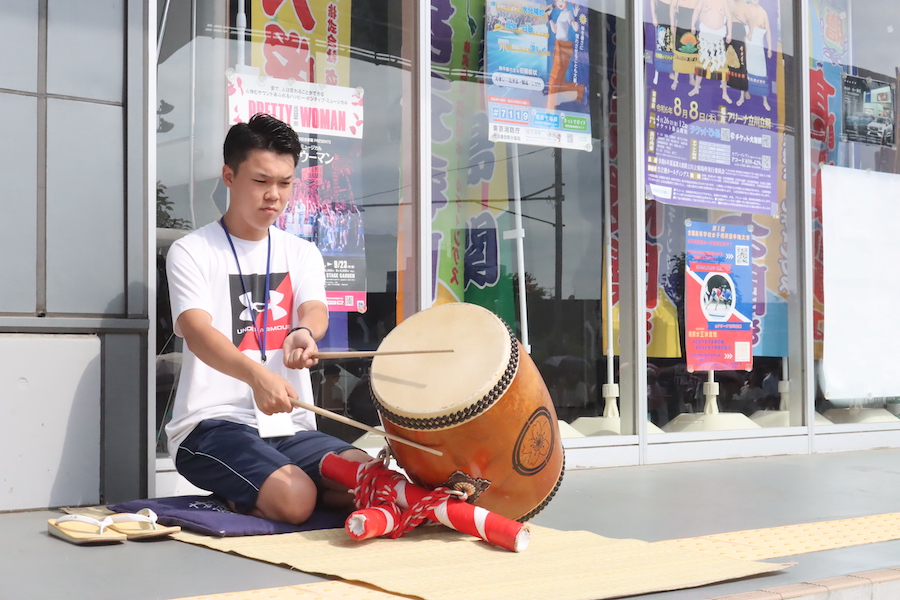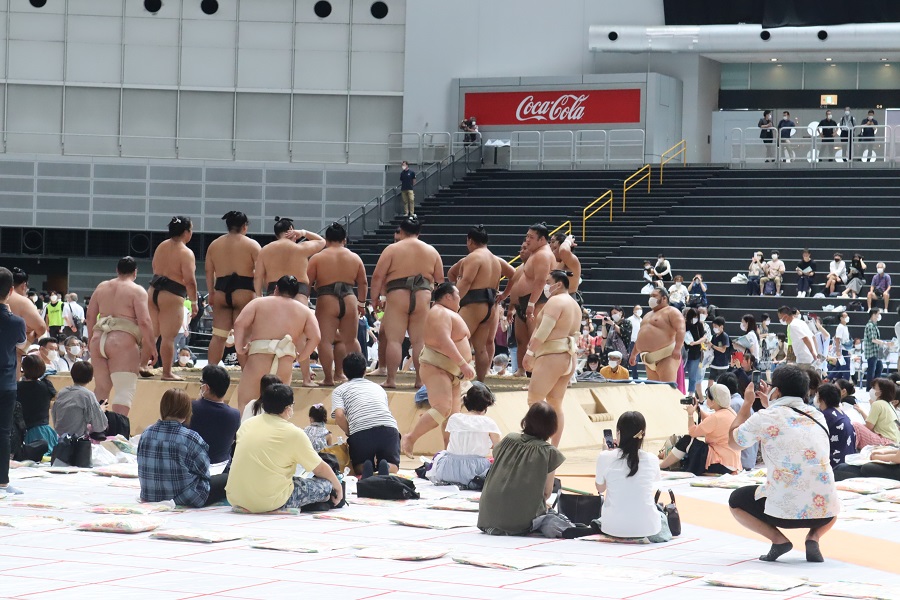A day at Jungyo (Provincial Tour)
In Japan, you can get up-close sumo experiences throughout the year. Aside from the Grand Sumo Tournaments, the Jungyo provincial tour travels to various locales in April, August, October, and December.
Here’s a typical schedule:
The wrestlers’ training sessions begin early in the morning.
The actual bouts will follow, and the event ends around 3 p.m.

9:00 – Gates Open & Morning Taiko
Yobidashi ring announcers beat a taiko drum to signal the commencement of the event.

9:30 – Training sessions finish for wrestlers ranked Makushita and below
Those who compete in the third-highest Makushita division and below have high aspirations. They start and finish their intense training early to make way for the upper-division rikishi.

9:30 to 11:30 – Training sessions for Juryo and Makunouchi wrestlers
Juryo division wrestlers are the first to train in this time frame. When their workout ends, those in the top Makunouchi division enter the ring. The top two ranks, Yokozuna and Ozeki, are the last. As time progresses, you can sense the level of skill rising and feel the determination of those in the upper echelons to succeed.

12:00 noon – Actual bouts start
Matches for the Makushita division and below go first. The crowd comes to life whenever wrestlers from that area enter the ring. Jonidan, Sandanme, and Makushita divisions occupy the main stage.
During the matches, you can enjoy special performances such as Shokkiri (comic sumo), Sumo Jinku (sumo folk songs), and Yagura-daiko uchiwake (taiko drumming) that you won’t find during Grand Sumo Tournaments.
Between the matches, you may get to see presentations by local patrons, things like topknot hairdressing demonstrations and Yokozuna rope-tying performances.

1:30 – Dohyo-iri / Ring-entering ceremony
Those who compete in the second-tier division wear handsome ceremonial aprons for the Juryo dohyo-iri proceedings. Soon after, the young enthusiastic wrestlers and seasoned veterans begin their bouts.
After the intermission, it’s time for the Makunouchi ring-entering ceremony as the top division wrestlers wearing even more elaborate ceremonial aprons make their way to the dohyo.

1:30 – Yokozuna dohyo-iri / Yokozuna ring-entering ceremony
Accompanied by the sword-bearer and the dew-sweeper, the sumo grand champion performs the Yokozuna dohyo-iri.
It’s the highlight of all ring-entering ceremonies and a spectacular expression of the sport’s 1,500-year history.

1:50 – Makunouchi top division matches
Sumo’s top-tier wrestlers engage in fierce battles. Many are familiar faces to the spectators from TV broadcasts of the Grand tournaments. During the musubino-ichiban (the final bout), the level of excitement reaches its peak.

3:00 – Yumitori-shiki / Bow-twirling ceremony – Uchidashi (Closing ceremony)
Following the final bout, the bow-twirling ceremony marks the completion of all events for the day.
Attractions (Entertainment)

Sumo Jinku / Sumo folk songs
Sumo Jinku are traditional sumo songs performed by the wrestlers themselves, who often have surprisingly good voices. In the old days, the songs were referred to as kata, which means a form. Wrestlers would sing them while demonstrating offensive and defensive kata (forms & techniques) on the dohyo.
Nowadays, they wear ceremonial aprons while singing to the rhythm of hand-clapping and stamping of feet.

Shokkiri / Comic sumo
Two wrestlers explain sumo techniques and illegal maneuvers in a comical way on the dohyo. Shokkiri dates back to the Edo Period. The term Sho means beginning, while kkiri means end. The wrestlers enchant the audience by deftly demonstrating nifty techniques with a light touch.

Yagura-daiko uchiwake / Yagura taiko drumming
This kind of performance was introduced by the consummate Yobidashi master Taro.
- Yose-daiko / Yose taiko drumming
- The Sumo Kaisho, the predecessor of current Japan Sumo Association, used Yose-daiko as a signal to gather sumo elders (stablemasters) to discuss important matters.
- Ichiban-daiko / First taiko drumming
- This drumming is performed to pray for peace and bountiful harvests. It is considered to be purification drumming. In earlier times, it was done at two or three in the morning.
- Hane-daiko / Hane taiko drumming
- Hane-daiko drumming takes place upon completion of all the matches for a day. It is performed with the message, “Please have a safe trip home. Thank you for attending today’s event. We look forward to seeing you again tomorrow.” Therefore, Hane-daiko is not performed on single-day events or on the final day of a Grand tournament.




